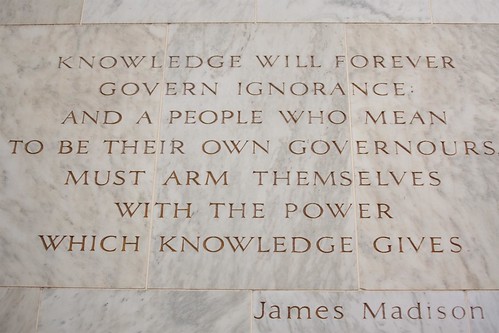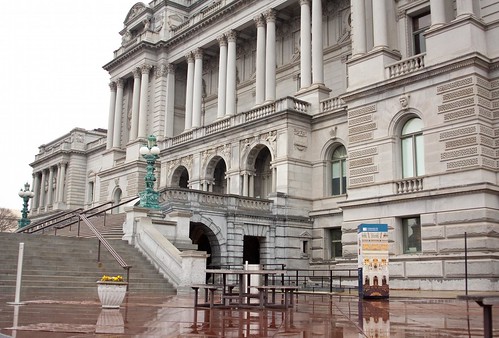The Library of Congress is open and free to any researchers, and I figure there comes a day in all of our lives when we need to look up the front page news on the day our moms were born, right? Right.
If you love books and love history, the Library of Congress is a must-see. Its collection includes 22 million books, and its architects built it as a cathedral to human knowledge. The Main Reading Room in the Thomas Jefferson Building is one of the most impressive and ornate rooms in all of DC.
A bonus is that you get to go home with a nice, little souvenir: A Library of Congress library card.
Here’s how you do it…
1. Enter the Library through the Madison Building. The Library of Congress consists of three buildings on Capitol Hill: the Thomas Jefferson Building, the John Adams Building, and the James Madison Building.
Across from the Capitol Building complex and Supreme Court Building, you’ll see the extremely ornate Jefferson Building with its faint green oxidized street lights and water features. This is not where you are going. Head across Independence Avenue to the modern, blockish Madison Building (floor plan).
Enter through the front doors, and go through the quick security screening – bags and metal objects on the conveyor belt through the scanner, walk through the metal detector.
2. Before using the Library, you’ll have to get a library card. This is very easy and takes about 10 minutes. After walking through security, take an immediate left and head to room LM-150 on your left. It is both the coat check and reader registration room.
Walk past the coat check (you’ll return to it) and enter the reader registration room. Just inside the doorway, there will be a reception desk and the receptionist will ask you what you are there for – lost or stolen library card? New library card? Let him/her know that you would like to get a new library card and that you are there for research purposes.
Walk straight ahead to the bank of computer tables. You’ll have to fill out a very simple online form: name, address, phone number. Click on submit then walk a few feet over to the photo-taking area. There are a few chairs lined up if there’s a wait.
When the clerk is open, head on over to his/her desk. He will take a photo of you then print out your card. You are all ready to go!
3. As you exit the reader registration room, you’ll have to check all of your belongings and coat if you’re wearing one. Them’s the rules at the Library of Congress. I recommend holding on to your wallet, since you’ll need cash to buy a printer card.
4. The Library isn’t exactly well signed. Actually, it’s a maze. Total confusion. If you like the idea of looking up old newspapers on microfiche, take a left out of LM-150 and head towards the Periodicals Room at LM-133 on the same floor. You’ll see a set of very heavy looking double doors, no windows. That’s where you’re headed.
Once inside, you’ll have to sign in – name, time, etc – and show off your new library card.
Just behind the circulation desk to the right, you’ll see all the microfiche cabinets. Newspaper names are displayed on top of each cabinet, and from there, you go by date.
When you find the right date range, pull out the little cardboard box with the microfiche canister and head to the microfiche reading cubbies. I could try to explain how to thread up a microfiche, but this video does an excellent job of showing you how it’s done.
5. If you want to print something out, you’ll have to feed a $1 bill into the printing card kiosk near the microfiche cubbies. The card will come preloaded with $.40. Copies are $.20 each. Feed the printing card into the little terminal next to your microfiche machine and print.
My mom’s birthday yielded the Philadelphia Warriors losing to the Minneapolis Lakers (this was before their move to LA). It was also a momentous day for the Marshall Plan – the first shipment of military aid left for France.
My dad was born during World War II, and it’s surprising but not surprising that every article has to do with the war. Even the book reviews and the Arts section. There was a celebration the day before in Philadelphia, with two submarines launched out of a shipyard on the Delaware River near Philadelphia. Unfortunately, one of them sank on her maiden voyage — she went off to patrol the Yellow Sea and was never heard from again.
6. You’ll want to check out Main Reading Room in the Jefferson Building during your visit.
Head towards the elevators and go down to the “C” level. In the basement, head north for the underground tunnel that leads to the Jefferson Building. (There is also a little snack bar and coffee shop down there, if you want to sit down for a moment.)
Where the Congressional buildings are all swank, all the time, the Library of Congress is reminiscent of a well-used college library. The underground tunnels connecting the buildings look like a service area — a little shabbier than the New York City Subway system. The walls are lined in beige, yellow subway tile. Floors are drab grey concrete. Library of Congress staff roll large bins full of books past researchers wearing backward baseball caps and college sweatshirts.
Once you’re through the tunnel, follow signs for the Jefferson Building (as opposed to the Adams Building). When you get to an old-timey elevator, head up to the first floor. You’ll have to walk past people’s offices and random doorways to get to the Main Reading Room, but it’s worth it.
Only “researchers” are allowed in the Main Reading Room. (The first time I used it, I actually was researching something. Pretty hard core.) If you are quiet and humble, though, you can show your library card to the receptionist, sign in, and walk right in. Despite being full of folks bent over books and walking around, the room is silent. I decided to take a seat near the door and try to stay out of their way.
This might be the most ostentatious room in all of DC. And that’s saying something. The room is an octagon (appropriately enough for the Jefferson Building), lined with three stories of balconies all full of books. The room is capped with a massive blue dome. On the floor, dark wood curved tables form concentric circles emanating from the center circulation desk. Each place setting is lit by a bronze reading lamp.
The top of each octagonal wall is topped with a half dome, with two bronze statues of literary and religious figures – Kent, Shakespeare, St. Paul, Moses, etc. The walls are marble, in shades of pink, rose, and beige. At each corner of the octagon, a marble column rises up up up, topped with a cascade of gilded leaves and marble statues. The marble statues are each a personification of a field of academic study, like commerce, history, and law. Above each statue, pairs of marble cherubs hold up gilded quotes: “The inquiry, knowledge, and belief of truth is the sovereign good of human nature.” “Of law there can be no less acknowledged than that her voice is the harmony of the world.”
Then there’s the dome itself. Circling the dome are depictions of 12 countries, deemed the most influential in 1897 when the Library was built. Judea (“Religion”) is wearing a green robe, with her palms pressed together above her head. France (“Emancipation”) is depicted as Marianne, wearing her red Cap of Liberty and a red, white, and blue sash.
All in all, it’s a room that you could take in for a half hour or more, with symbolism crammed into every crevice and drawing.
The Library of Congress Complex is massive and worth exploring (that’s the floorplan). You might also want to check out whether there are any lectures going on during your trip. Enjoy!









